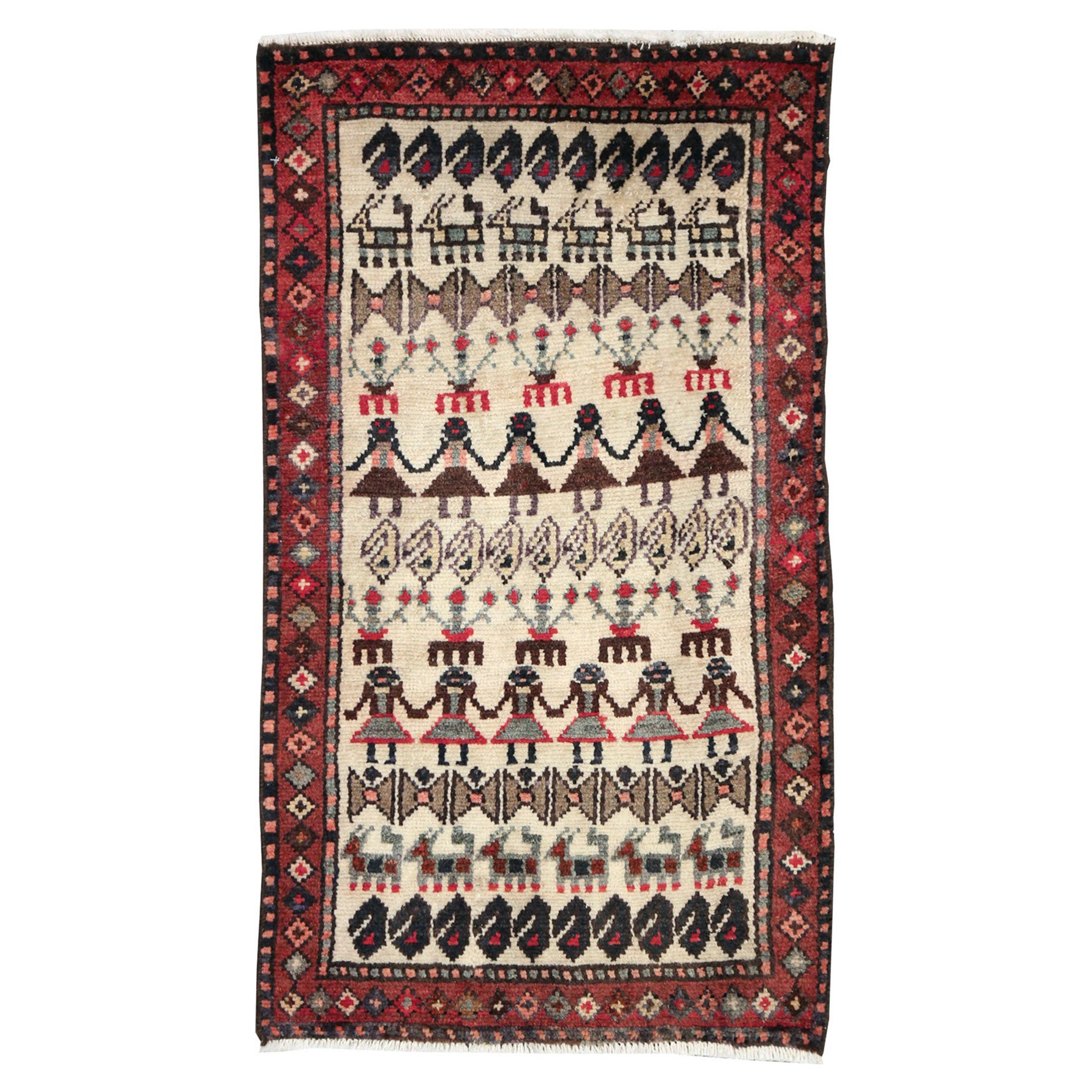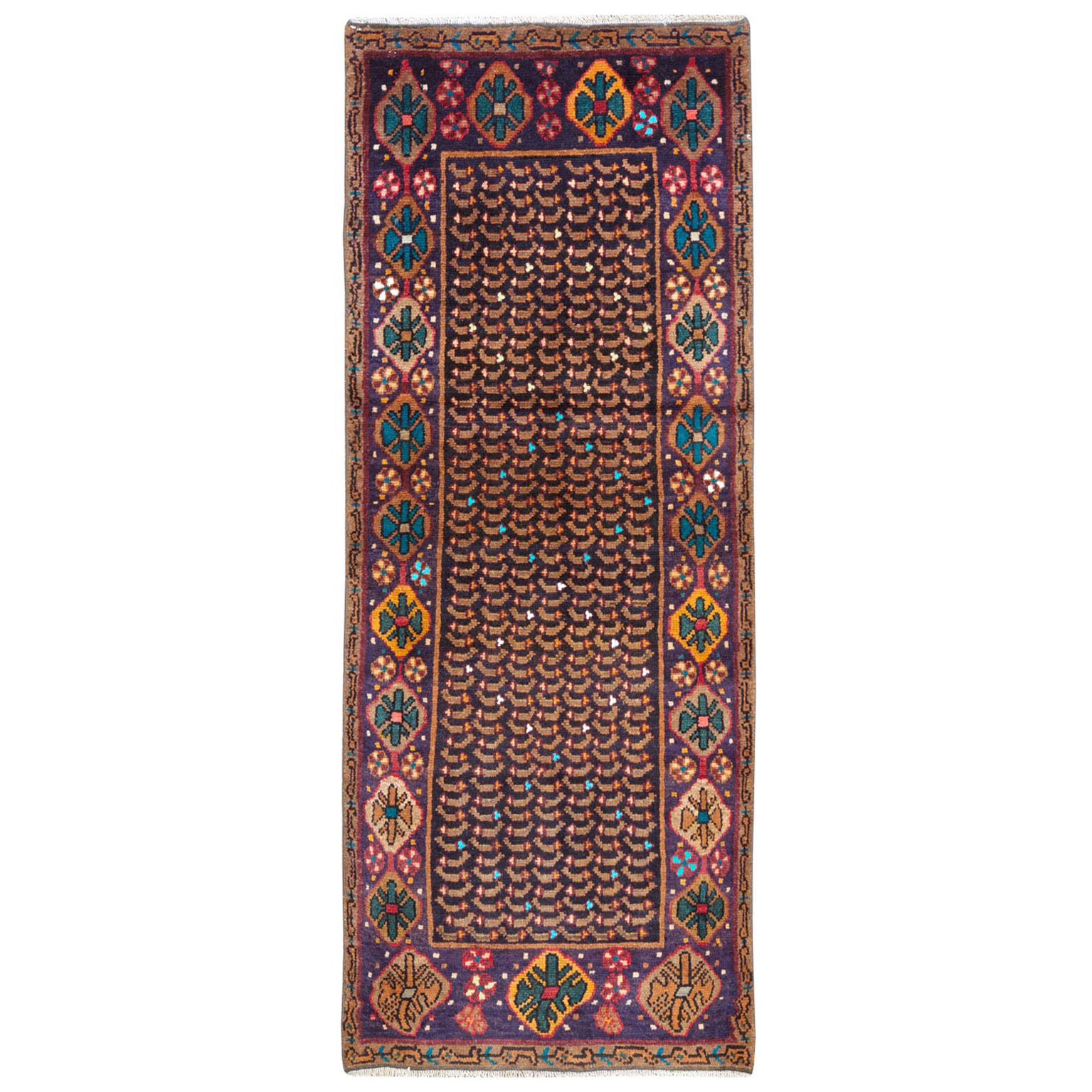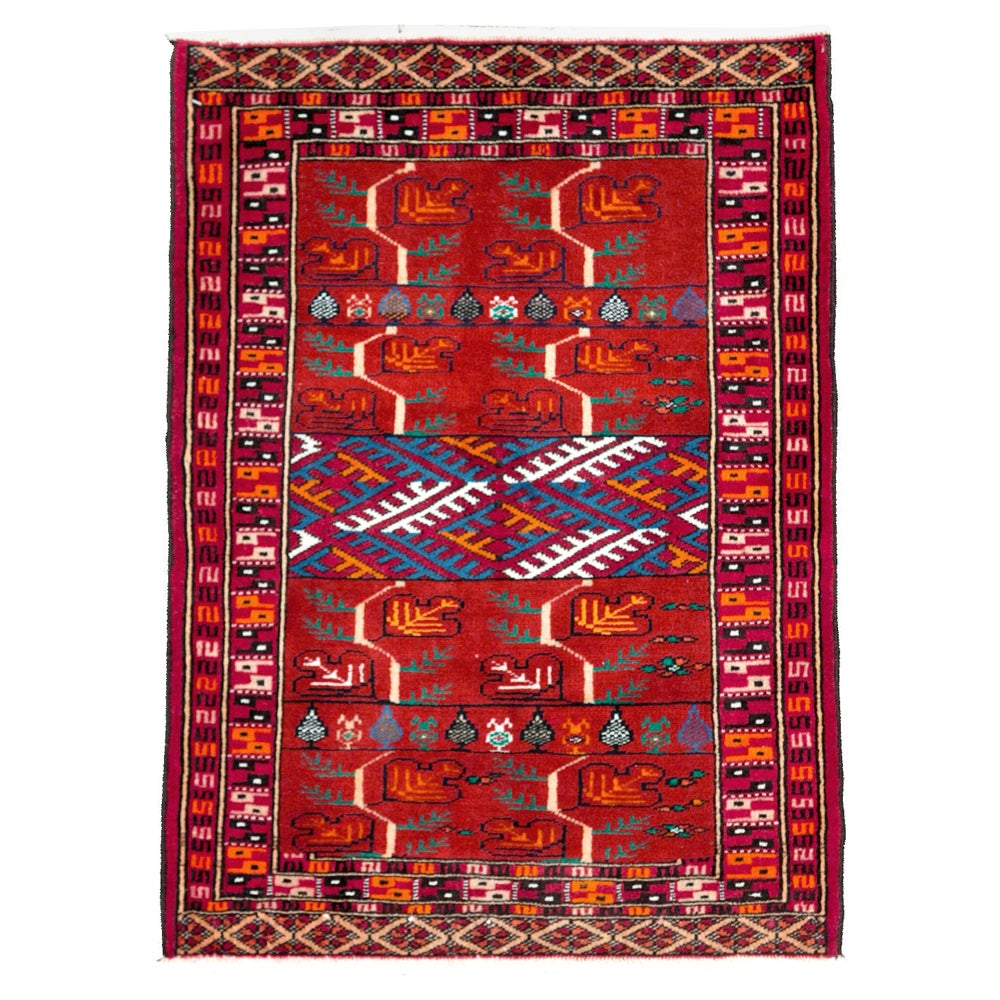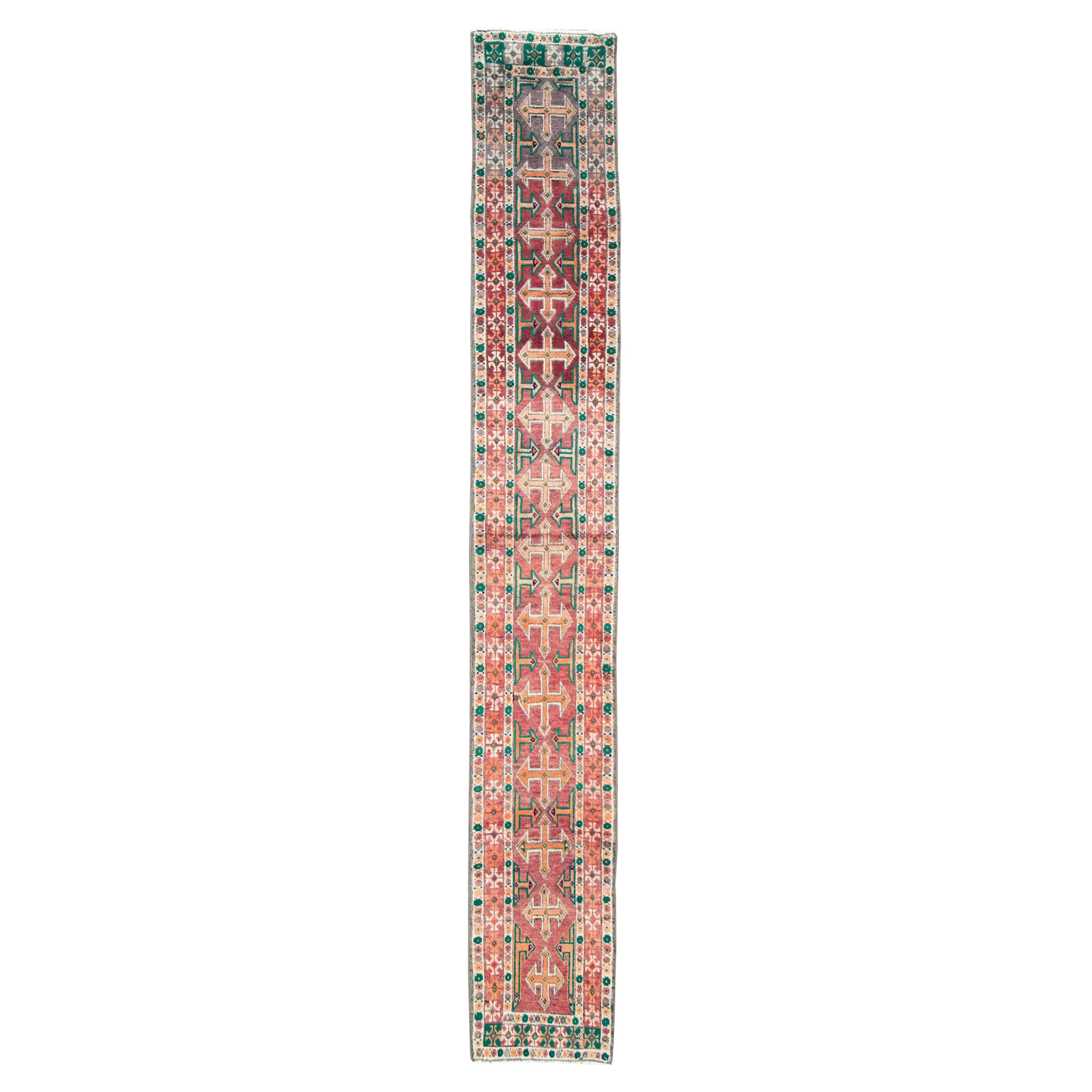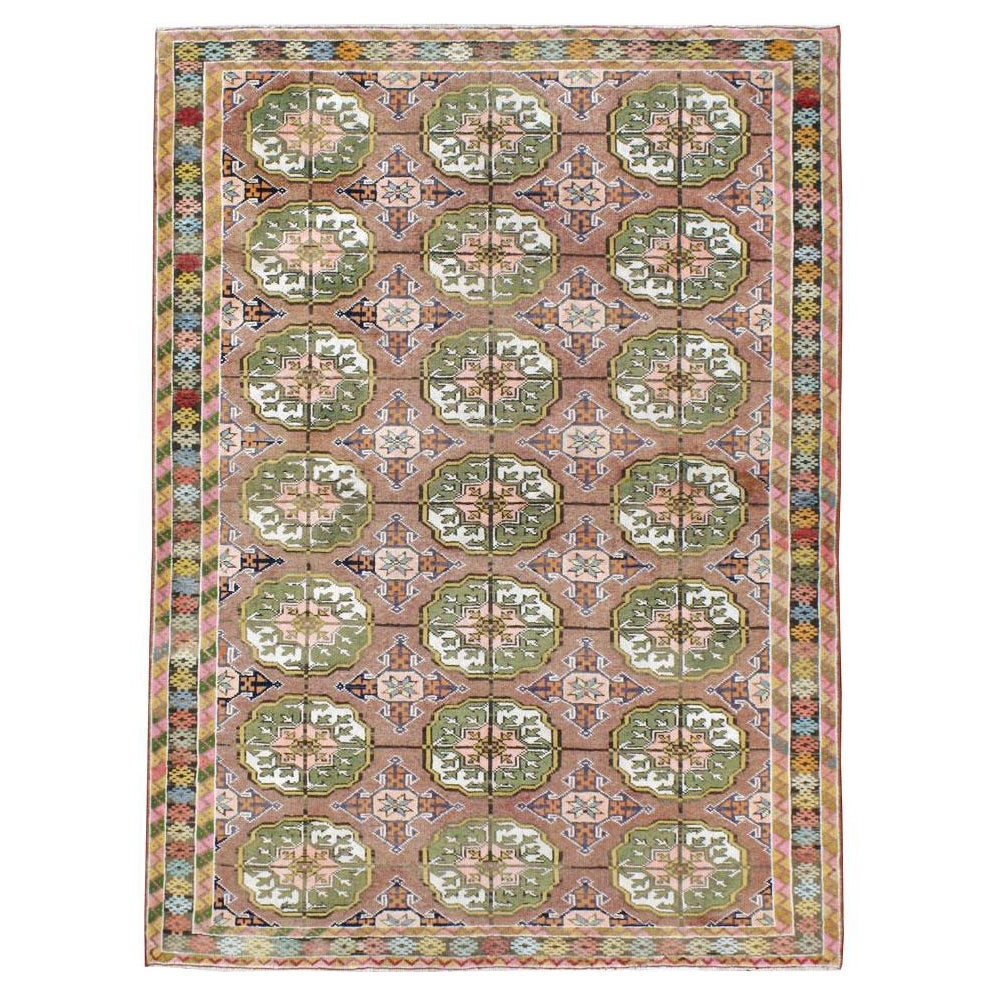Items Similar to Mid-20th Century Handmade Persian Baluch Throw Rug
Want more images or videos?
Request additional images or videos from the seller
1 of 10
Mid-20th Century Handmade Persian Baluch Throw Rug
About the Item
A vintage Persian Baluch throw rug handmade during the mid-20th century.
Measures: 3' 5" x 6' 0"
Persian rugs & carpets:
Persia (Iran) is a moderately large country with a very long history and an enormous art/craft/industry built around the handmade carpet. Until the discovery of oil, carpets were the largest Persian export. The craft goes back to ancient times, although the history is more broken than one might expect or desire. The Pazyryk rug dates from the 3rd/4th century B.C.E., but really no carpets before 1500 or so survive in any sort of numbers. Persia is an upland plateau region, semi-arid in many places, verdantly fertile in others, and a perfect base for a pastoral economy. Sheep beget wool and wool begets rugs. Lots of rugs. Almost every province, city, town, village and tribe made or makes rugs with distinctive local characteristics. The rug literature identifies many of these, but thousands of more locales and tribal segments cannot be connected to known examples and vice versa.
There are essentially three (or four) distinct rug genres: the urban workshop formal rug; the village informal type; and the tribal/nomadic really informal kind. A fourth type is the royal or imperial carpet, woven for the Shah in court ateliers. Workshop, village and tribal rugs will be considered in more depth in specialized essays. Persian rugs must be woven in Persia. Being “in the style of….” does not count. On the other hand, the universally high standards of Persian rug weaving have raised the levels of carpet craftsmanship all over the rug belt. Everyone wants to be Persian, at least where rugs are concerned. “Persian rug” and “Oriental rug” used to be synonymous.
Persian rugs come in all grades. From ultra-coarse tribal rugs to incredibly fine silks from Tabriz and planned urban Isfahan pieces. Persian rugs also come in all sizes. From miniature throw rugs to pieces as large as a parking lot. In weaves from 20 knots per square inch to 2000; in wool, silk, combinations thereof, and more modern synthetic and natural fibers. With natural and synthetic dyes. Most Persian weavers are women, in all contexts, but everybody can weave rugs. The Great Persian Carpet Revival began in the 1870s and the industry mushroomed, with many cities, villages, and tribes taking up or radically expanding rug weaving, from an occasional domestic art to a full-time professional industry. For example, Tehran, the capital, developed an industry-oriented exclusively toward very fine, totally designed carpets for the nascent Persian upper classes. A few rugs were exported, but most went to the wealthy. But this industry did not last past the Interwar period. Other cities have been weaving rugs for centuries. Tabriz, an early capital, has been weaving fine rugs since the 16th century, and with an interruption, has a flourishing industry today. Other cities developed carpet industries as demand expanded around 1900. Before then, nothing much in Mashad, after that lots of activity. Towns like Nain and Qum started from nowhere in the ’30s and now have crafts wholly oriented toward high-quality pieces.
Villages all around Persia have contributed their share to the middle market, but 20th century (and later) pressures have pushed them toward higher qualities, more in the urban manner. This quality upgrade has also affected the nomadic, tribal weavers. Once weaving a few rugs for themselves for domestic consumption, they are now almost exclusively weaving for the market and in competition with urban rugs. So, they have moved up in quality and style.
The Persian carpet is not a static kind of thing, and neither is the craft supporting it. Forget the “timeless east”. Rugs are objects of fashion, with innovations beginning at or near the top, and working their way downward as styles become accepted. Because rugs are a worldwide export, foreign influences seep or crash in. Whole new genres are imported. The red “American Sarouk” detached floral spray style was imported around 1920 and quickly became popular all over Iran, in scatters, room sizes, and runners. Not Persian, but “Persian”. Now accepted everywhere. Rugs are viewed in Iran as art objects, and artists everywhere have always taken advantage of innovations in techniques and materials. In Persia, this has meant machine-spun threads and yarns, synthetic dyes, and chemical washing manipulation. Some experiments lead to real improvement, some are unfortunate dead ends. Some patterns are wildly successful, others are quickly discarded. The allover Herati, Mina Khani, Boteh (paisley or cone), and Gol Hennai patterns have proliferated, and the medallion and corners layout in its infinite variety is virtually synonymous with Persian rugs. Persian weavers seem to have invented all these and more. Today, very finely woven photographic pictorials are fashionable. Who knows if this innovation will last?
A basically semi-desert land needs color, has to have color in its furnishings and household accouterments. Persian rugs are all about color. All types revel in true color: saturated reds, deep blues, salmon, sky blue, cerulean, yellows from mustard to lemon, near black, cream and ecru and ivory, greens from teal to turquoise. From the Orient comes light, and light means color. A real, genuine Persian rug is richly, complexly colored. Maybe too rich. The carpets of the Chahar Mahal (“Bakhtiari”) area are just too colorful, too saturated for the American market. But they go over just fine in Persia. No blah rugs there. Current American decorating trends have shied away from color, complexity, and boldness. Whether these are “coming back” is a question. They have never gone away in authentic Persian rugs.
A tour of the country shows urban weaving centers around the border edge, with a central spine; village weavers in the countryside surrounding the cities; and tribal weavers filling the blank spots almost everywhere. Some towns have been continuously active for centuries, like Kerman; some with interruptions like Isfahan, Kashan, or Tabriz; and some are relative newcomers like Qum and Nain. The picture is incomplete and much of the 18th and 19th centuries have been long ignored. There are large gaps with no extant specimens. But also, discoveries of previously ignored tribal and village weaving keep coming. New types get explored and the picture fills in. Whatever story you believe, it is probably only a fraction of the rich history of the Persian carpet.
About the Seller
5.0
Platinum Seller
These expertly vetted sellers are 1stDibs' most experienced sellers and are rated highest by our customers.
Established in 1989
1stDibs seller since 2009
560 sales on 1stDibs
Typical response time: 1 hour
- ShippingRetrieving quote...Ships From: New York, NY
- Return PolicyA return for this item may be initiated within 3 days of delivery.
More From This SellerView All
- Mid-20th Century Handmade Persian Baluch Accent RugLocated in New York, NYA vintage Persian Baluch accent rug handmade during the mid-20th century with cotton highlights. Measures: 5' 3" x 9' 0".Category
Mid-20th Century Persian Tribal Persian Rugs
MaterialsWool
- Mid-20th Century Handmade Persian Baluch Throw RugLocated in New York, NYA vintage Persian Baluch throw rug handmade during the mid-20th century with bright cotton highlights. Measures: 1' 10" x 3' 2" Persian rugs & carpets: Persia (Iran) is a mode...Category
Mid-20th Century Persian Tribal Persian Rugs
MaterialsWool, Cotton
- Mid-20th Century Handmade Persian Baluch Throw RugLocated in New York, NYA vintage Persian Baluch throw rug handmade during the mid-20th century. Measures: 2' 4" x 5' 4"Category
Mid-20th Century Persian Modern Persian Rugs
MaterialsWool
- Mid-20th Century Handmade Central Asian Turkoman Small Throw RugLocated in New York, NYA vintage Central Asian Turkoman small throw rug handmade during the mid-20th century. Measures: 2' 0" x 2' 9".Category
Mid-20th Century Central Asian Tribal Central Asian Rugs
MaterialsWool
- Tribal Mid-20th Century Handmade Persian Turkoman RunnerLocated in New York, NYA vintage Persian tribal Turkoman rug in runner format handmade during the mid-20th century. Although this rug is of Persian origin, the roots of Turkoman rugs originated in the Central Asian region. Measures: 1' 6" x 10' 4" Central Asian Rugs & Carpets: Central Asia is a vast area stretching from Northeastern Persia to western China, and from northern Afghanistan to the southern edge of Russia. The carpets can be usefully divided into three groups: the nomadic Turkmen rugs of Turkmenistan, northern Afghanistan, and northeastern Persia; the non-Turkmen tribal pieces from Kazakhstan, Uzbekistan, and Kirghizstan; and the urban creations of Khotan, Yarkand, and Kashgar, oasis cities of Western China (Xinjiang Province). Commercially, the most important group is from Khotan, the easternmost of the Chinese Turkestan cities. The craft of rug weaving is primarily in the hands of Muslim Uighurs. Khotan carpets mix purely Central Asian design themes with Chinese elements. Native Khotan devices include pomegranate trees, upright flowers, round medallions, and yellow or red grounds. Chinese motives include triangular fretwork corners, swastika fretwork, and Yun-Tsao Tou (clouds and rain) diagonally striped polychrome borders. Cotton foundations, asymmetrical (Persian) knots, and medium weaves are standard. Some vintage Khotan are in horizontal, pictorial layouts with multiple various vases and plants. Saphs (multiple prayer niche panel carpets) are also a Khotan specialty. Others employ stepped and layered lozenge medallions, singly or in pairs. Still others, almost all antique, feature a stylized version of the allover Persian Herati design. Many of the oldest pieces employ brown wool wefts. Antique and vintage Khotans are almost always in the k’ang (double square) layout, conforming to the local household plans. Only relatively recently has the 6’ by 12’ or 7’ by 16’ format been replaced by the 9’ by 12’ size. As a result, an antique room size Khotan carpet is very uncommon. Reds are cinnamon, tomato and rust, never wine reds, crimson, or scarlet. Yarkand, farther west on the old Silk Road specializes in multi-medallion long carpets while Kashgar, farthest west and most under Persian influence, has traditionally knotted allover pattern pieces with finer weaves, often with silk piles, and enriched with medal thread, on cotton foundations. Extant Kashgars go back to the 17th century, but the carpet craft in Chinese Turkestan must be much older as fragments have been recovered from local tombs of the early C.E. period. Kashgars are the rarest of all East Turkestan rugs. Most available vintage East Turkestan carpets are interwar Khotans, many with pleasingly soft decorative palettes. The non-Turkmen nomads include the Kazakh, Kirghiz, Uzbek, and Karakalpak groups. Like the Turkmen, they were once all seasonally migratory, dwelling in round felt tents (yurts), but have been settled, at least partially, in the villages, and have taken up crafts and agriculture instead of sheep herding. As a result, carpet production has transitioned from domestic tent use to commercial sale, but the roots of long traditions are still evident. The Uzbeks weave...Category
Mid-20th Century Persian Tribal Persian Rugs
MaterialsWool
- Tribal Turkoman Inspired Mid-20th Century Handmade Persian Malayer Accent RugLocated in New York, NYA vintage Persian Malayer accent rug handmade during the Mid-20th Century inspired by Central Asian tribal Turkoman carpets. Measures: 4' 7" x 6' 4".Category
Mid-20th Century Persian Tribal Persian Rugs
MaterialsWool
You May Also Like
- Antique Afghan Baluch Rug, Early 20th CenturyLocated in San Francisco, CAAntique Afghan Baluch Rug, Early 20th Century Additional Information: Dimensions: 10'2" L x 6'4" W Origin: Afghanistan Period: Early 20th Century Condition: ExcellentCategory
Early 20th Century Afghan Central Asian Rugs
MaterialsWool
- Antique Afghan Baluch Rug, Early 20th CenturyLocated in San Francisco, CAAntique Afghan Baluch Rug, Early 20th Century Additional Information: Dimensions: 8'6" L x 4'6" W Origin: Afghanistan Period: Early 20th Century Rug ID: 21808Category
Early 20th Century Afghan Central Asian Rugs
MaterialsWool
- Early 20th Century Persian Baluch RugLocated in Chicago, ILA stunning early 20th century Persian Baluch rug with an all-over diamond pattern woven with petite stylized flowers, all woven in orange, gold, white, and indigo wool, set against a...Category
Vintage 1930s Persian Tribal Persian Rugs
MaterialsWool
- Early 20th Century Persian Baluch RugLocated in Chicago, ILA beautiful early 20th century Persian Baluch rug with an all-over stylized flower pattern woven in red, orange, and black wool, set against a brown background. The border is wonder...Category
Vintage 1930s Persian Tribal Persian Rugs
MaterialsWool
- Early 20th Century Persian Baluch RugLocated in Chicago, ILA beautiful early 20th century Persian Baluch rug with a fantastic tribal pattern containing multiple stylized flowers woven in crimson, indigo, brown, and white, and surrounded by a...Category
Early 20th Century Persian Tribal Persian Rugs
MaterialsWool
- Beautiful Mid 20th Century Khotan RugLocated in Chicago, ILA beautiful mid 20th century Central Asian Khotan rug with an incredible pattern containing two tall footed vases, potted with exceptionally rendered stylized lotus flowers reaching ...Category
Vintage 1950s East Turkestani Khotan Central Asian Rugs
MaterialsWool
Recently Viewed
View AllMore Ways To Browse
Mid Century Since
Mid Century Built In
Make Up Mid Century
Mid Century Large Rug
Large Midcentury Rug
Mid Century Rug Black
20th Century Furnishings
Mid Century Picture Light
Yellow Midcentury Rug
Mid Century Rug Yellow
Midcentury Corner Light
20th Century No Rugs
Mid Century Colorful Rug
Midcentury Modern Corner Bar
Incredible Mid Century Light
Yellow Midcentury Modern Rug
Mid Century Central America Furniture
Mid Century Sheep

